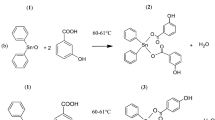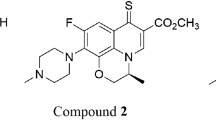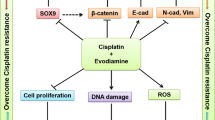Abstract
Purpose
Cyathocline purpurea has been traditionally used to treat various diseases including cancers for many years. However, these applications of C. purpurea have not been supported by pharmacological investigation. The objective of this study is to investigate the anticancer activities of three main constituents such as santamarine, 9β-acetoxycostunolide and 9β-acetoxyparthenolide isolated from C. purpurea in vitro.
Methods
Cell viability was determined by trypan blue exclusion and methylene blue assays. Colony formation was assessed by microtitration cloning assay. DNA synthesis was determined by tritiated thymidine incorporation assay. Cell cycle analysis was carried out by flow cytometry. Apoptosis was observed by DAPI staining assay and Caspase 3/7 activities was measured using Caspase-Glo® 3/7 assay kit.
Results
Santamarine, 9β-acetoxycostunolide and 9β-acetoxyparthenolide inhibited the growth of L1210 murine leukaemia, CCRF-CEM human leukaemia, KB human nasopharyngeal carcinoma, LS174T human colon adenocarcinoma and MCF 7 human breast adenocarcinoma cells in vitro, with IC50 in the range of 0.16–1.3 μg/mL. In L1210 model, santamarine and 9β-acetoxycostunolide inhibited L1210 cell growth, colony formation and [3H]-thymidine incorporation in time- and concentration-dependent manners. Flow cytometry studies showed that santamarine and 9β-acetoxycostunolide blocked L1210 cells in the G2/M phase of the cell cycle. DAPI staining and caspase activity assays showed santamarine and 9β-acetoxycostunolide induced apoptosis and activated caspase 3 in L1210 cells.
Conclusions
These results indicated that santamarine, 9β-acetoxycostunolide and 9β-acetoxyparthenolide exhibit significant anticancer activities in vitro. The inhibitory effects of santamarine and 9β-acetoxycostunolide on L1210 cells are cytotoxic rather than just cytostatic. They block mitosis and reduce uptake of thymidine. The mechanism of the cytotoxicity of santamarine and 9β-acetoxycostunolide to L1210 cells could be related to alkylation of the sulfhydryl enzymes involved in nucleic acids and protein synthesis, as previously found for other sesquiterpenes with the α-methylene-γ-lactone moiety present in santamarine, 9β-acetoxycostunolide and 9β-acetoxyparthenolide. It may also be related to suppression of microtubular proteins. Santamarine and 9β-acetoxycostunolide induced apoptosis of L1210 cells via activation of caspase 3.







Similar content being viewed by others
References
Yu C, Huang T, Ding Z, Gao X and Zhang Z (eds) (1993) Encyclopaedia of Chinese medicines, Chinese Medicinal Science and Technology Press, Beijing, vol 1, item 9766
Li Z, Ma G, Luo L, Huang R (2006) Sesquiterpene lactones from Cyathocline purpurea. Gaodeng Xuexiao Huaxue Xuebao (Chem Chin Uni) 27:1–4
Rodriguez E, Towers GHN, Mitchell JC (1976) Biological activities of sesquiterpene lactones. Phytochemistry 15:1573–1580
Picman AK (1986) Biological activities of sesquiterpene lactones. Biochem System Ecol 14:255–281
Lee KH, Huang ES, Piandosi C, Pagano J, Geissman TA (1971) Cytotoxicity of sesquiterpene lactones. Cancer Res 31:1649–1654
Lee KH, Haruna M, Huang HC, Wu BS, Hall IH (1977) Antitumor agents 23: helenalin, an antitumor principle from Anaphalis morrisonicola. J Pharm Sci 66:1194–1195
Kupchan SM, Eakin MA, Thomas AM (1971) Tumor inhibitors. 69. Structure-cytotoxicity relationships among the sesquiterpene lactones. J Med Chem 14:1147–1152
Hladon B, Drozdz B, Holub M, Szafarek P, Klimaszewsk O (1978) Sesquiterpene lactones (SL) Part XXIV. Further studies on cytotoxic activities of SL in tissue culture of human cancer cells. Pol J Pharmacol Pharm 30:611–620
Mondranondra IO, Che CT, Rimando AM, Vajrodaya S, Fong HHS, Farnsworth NR (1990) Sesquiterpene lactones and other constituents from a cytotoxic extract of Michelia floribunda. Pharmaceut Res 7:1269–1272
Goren N, Woerdenbag HJ, Bozok-Johansson C (1996) Cytotoxic and antibacterial activities of sesquiterpene lactones isolated from Tanacetum prarteritum subsp. praeteritum. Planta Medica 62:419–422
Roper PR, Drewinko B (1976) Comparison of in vitro methods to determine drug-induced cell lethality. Cancer Res 36:2182–2188
Finlay GJ, Baguley BC, Wilson WR (1984) A semiautomated microculture method for investigating exponentially growing carcinoma cells. Anal Biochem 139:272–277
Geran RI, Greenberg NH, MacDonald MM, Schumacher AM and Abbott BJ (1972) Protocols for screening chemical agents and natural products against animal tumors and other biological system, part 3. Cancer Chemother Rep 3:103
Moncrief JW, Heller KS (1967) Acylation: a proposed mechanism of action of various cytotoxic agents on model chemical systems. Cancer Res 27:1500–1502
Hartwell JL, Abbott BJ (1969) Antineoplastic principles in plants: recent developments in the field. In: Garattini S, Goldin A, Hawking F, Kopin IJ (eds) Advances in pharmacology and chemotherapy, vol 7. Academic Press, NY, pp 117–210
Kupchan SM, Fessler DC, Eakin MA, Giacobbe TJ (1970) Reactions of alpha methylene lactone tumour inhibitors with model biological nucleophiles. Science 168:376–378
Woerdenbag HJ, Meijer C, Mulder NH, de Vries EGE, Hendriks H, Malingre TM (1986) Evaluation of the in vitro cytotoxicity of some sesquiterpene lactones on a human lung carcinoma cell line using the fast green dye exclusion assay. Planta Medica 52:112–114
Hladon B, Drozdz B, Holub M, Bobkiewicz T (1975) Sesquiterpene lactones XVI. In vitro studies in tissue cultures of human and animal malignant cells. Arch Immunol Therap Experimentalis 23:845–855
Ma G, Khan SI, Benavides G, Schuhly W, Fisher NH, Khan IA, Pasco DS (2007) Inhibition of NF-kB-mediated transcription and induction of apoptosis by melampolides and repandolides. Cancer Chemother Pharmacol 60:35–43
Kupchan SM (1974) Novel natural products with antitumor activity. Fed Proc 33:2288–2295
Hall IH, Lee KH, Mar EC, Starnes CO (1977) Antitumor agents. 21. A proposed mechanism for inhibition of cancer growth by tenulin and helenalin and related cyclopentenones. J Med Chem 20:333–337
Grippo AA, Hall IH, Kiyokawa H, Muraoka O, Shen Y-C, Lee K-H (1992) The cytotoxicity of helenalin, its mono and disfunctional esters, and related sesquiterpene lactones in murine and human tumor cells. Drug Des Discov 8:191–206
Binder C, Hiddemann W (1994) Programmed cell death: many questions still to be answered. Ann Hematol 69:45–55
Bursch W, Oberhammer F, Schulte-Hermann R (1992) Cell death by apoptosis and its protective role against disease. Trends Pharmacol Sci 13:245–251
Lowe SW, Lin AW (2000) Apoptosis in cancer. Carcinogenesis 21:485–495
Salvesen GS, Dixit VM (1999) Caspase activation: the induced-proximity model. Proc Natl Acad Sci USA 96:10964–10967
Author information
Authors and Affiliations
Corresponding author
Rights and permissions
About this article
Cite this article
Ma, G., Chong, L., Li, Z. et al. Anticancer activities of sesquiterpene lactones from Cyathocline purpurea in vitro. Cancer Chemother Pharmacol 64, 143–152 (2009). https://doi.org/10.1007/s00280-008-0863-y
Received:
Accepted:
Published:
Issue Date:
DOI: https://doi.org/10.1007/s00280-008-0863-y




